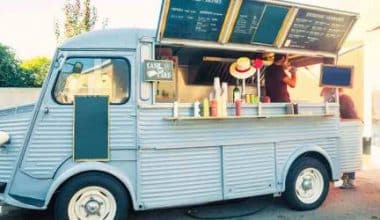It’s natural to have doubts about your decision to open a restaurant, as doing so involves a lot of hard work and demands a lot of time and energy. You want to be your own boss, run a small business, and prefer a restaurant. Although opening a restaurant is no easy feat, it is possible with careful and expert planning. If you are looking for information about starting a restaurant but don’t know where to start, this is the best place to be. From conducting market research to creating a business strategy, this guide will walk you through the checklist, cost, and steps involved in opening a restaurant even if you plan to start one with no money.
Overview
According to the National Restaurant Association, there were over a million restaurants operating in the United States as of the beginning of 2020, employing around 15.6 million people and generating $899 billion in sales. However, over the course of the COVID-19 pandemic, it is believed that as many as 100,000 eateries have permanently shut down.
That’s why it’s more important than ever before for would-be restaurateurs to weigh all the factors that go into making a restaurant a success before taking the plunge.
When it comes to starting and growing a career, few other sectors can compare to the exciting and dynamic environment provided by the restaurant industry. It’s also quite difficult to generate money in the restaurant industry, and competition is severe. Exclusive Toast data shows that the average monthly income for a restaurant that is less than a year old is $111,860.70. Most restaurants see a profit margin of between 3 and 5 percent.
Restaurant owners all throughout the country are still reeling from the consequences of the coronavirus as the industry works to recover. The restaurant industry has adapted to the current climate of uncertainty by embracing novel dining experiences and a wide range of revenue streams. Many people still dream of opening their own restaurant, so we made a checklist to help you get started.
Checklist for Opening a Restaurant
A restaurant’s opening checklist is a to-do list containing all the processes and stages involved in setting up your restaurant from scratch. Whether you decide to design the checklist yourself or work with an expert planner, once it is printed, it will give you an idea of what you’re about to venture into and you can easily kick start your journey of opening a restaurant.
The checklist for opening a restaurant, which usually includes a step-by-step guide or maps to your journey as a restaurant owner, ensures that no important plans or actions to make the business successful are forgotten.
This checklist is especially crucial if you are opening up a restaurant yourself without the help of an expert planner.
Here is a checklist for opening a restaurant;
- Decide on a Restaurant Idea, Concept, and Brand (niche)
- Create your restaurant business plan.
- Choose a restaurant name and legal structure.
- Secure Funding for your New Restaurant
- Select the perfect restaurant location.
- Get Licenses and Permits.
- Create Your Restaurant’s Menu and Beverage Program.
- Hire restaurant staff.
- Invest in the Right Tools for Your Restaurant
- Create a restaurant marketing plan
- Prepare for a Grand Opening and a Soft Opening
With the above opening a restaurant checklist, you will be able to;
- Formulate an editable restaurant business plan format to help you visualize your ideas
- Know how to get the money and financing you need to open a restaurant.
- Decide on what sorts of authorizations and registrations are required for opening a restaurant.
- Discover helpful hints for restaurant advertising
- Get further information that will help your new restaurant succeed.
We will discuss all items on the opening a restaurant checklist in full length later, under the steps of kickstarting a successful business.
Is it Hard to Open Your Own Restaurant?
Generally, it might be an extremely difficult and complicated task. Even the most methodical and in-control person might find the process of opening a restaurant to be incredibly challenging and stressful. However, once you get the doors open and people or customers start coming in, it will all be worth it. It can be good to have an idea of the potential challenges you will face before you begin the process. This will help you prepare for them in advance and deal with them in a way that reduces your level of stress.
How Much Money Do You Need to Make a Restaurant?
According to Fit Small Business, the overall cost of opening a restaurant can range anywhere from $95,000 to over $2 million. However, the actual cost you will use for opening your restaurant depends on certain factors, such as the rent you pay, the furniture you choose, and the way in which you renovate your space.
Cost for Opening a Restaurant
Let’s say you have a creative spirit and an insatiable appetite for business. The decision to strike out on your own and open a restaurant, however, raises a number of questions. One of the most common first questions is how much money it will cost you if you’re opening up a restaurant. Generally, there are no definitive responses to these inquiries. There is no simple answer because it depends on details like the type of restaurant you want to launch, the location you choose, and the size of the establishment you envision. Do you want to eat in the restaurant, have it delivered, or both? With this information in hand, you’ll be better able to determine what has to be done to boost restaurant sales.
The average cost for opening a restaurant is between $175,500 and $750,000. Now, we’ll talk about the finances involved in starting a successful restaurant.
#1. Food Cost
Your running costs will be significantly impacted by the price of food. It accounts for between 28%-35% of a restaurant’s permanent costs. The menu items you choose can also have an impact on the final price. A steakhouse’s food expenditures could be as high as 40 percent, while those of an Italian restaurant might be closer to 28 percent.
Consider each menu item’s profit. A menu item with 35% food costs may generate more profit due to higher sales volume and customer demand. And it’s important to advertise based on “gross profit contribution” rather than food prices alone.
In addition, food inflation is another factor, while extreme weather, like a hurricane, can change the status quo. You’re basically vulnerable to demand and price trends; avocados and other fresh produce may become more expensive if demand suddenly rises.
One more thing: don’t waste food. Finding a balance between insufficient and excess food is difficult. 58% of restaurants can’t keep track of their inventory, leading to overordering and financial waste.
#2. Labour Cost
Hourly salaries, paid time off, paid sick days, employee benefits, payroll taxes, and other labor-related expenses add up quickly.
In order to maintain a profit margin, restaurants often limit their payroll expenses to between 25 and 30 percent of total revenue. The lowest end of the spectrum is represented by quick-service eateries, while the highest is reserved for more elegant dining establishments. Wondering how to figure out your labor’s share of the total cost?
The cost of labor might fluctuate based on factors including market conditions and new legislation. These prices may also rise due to a lack of available workers. According to research, seven out of ten restaurant establishments have trouble hiring qualified candidates.
#3. Rent
Every restaurant requires a place to set up shop, and the cost of that spot will change depending on what you’re hoping to accomplish. It will be far more expensive to build a large restaurant with a full dining room than a smaller restaurant that will focus on takeout and delivery. Five to ten percent of a restaurant’s total monthly expenses often go toward rent. According to a survey, the average monthly rent for a restaurant is $5,000.
#4. Technology Cost
The restaurant sector has undergone a dramatic transformation over the past two decades, with technology now serving as the backbone of the consumer experience. Poor customer experiences, caused by a lack of adequate technology, can have an immediate and detrimental effect on revenue. Consider the following while planning for technology:
- A method of organizing work hours for staff members. A scheduling system can be a useful resource, as nearly one-quarter of restaurants report spending three hours or more per week on personnel schedules.
- Point-of-sale (POS) technology. The smooth operation of your business depends on your point-of-sale system. In addition, seventy percent of restaurants say increased profits are a direct result of their POS system’s analytical capabilities.
Depending on the methods you choose, the price of your technology may rise or fall. Regardless, select technology that provides you access to insights. With these nuggets of knowledge, you’ll be able to see the various moving parts of the sales machine from every angle.
Additional Cost
There are a few other types of expenses to factor in as you calculate the total cost of opening your restaurant.
- Marketing Cost
- Expenses for decoration and renovations
- Equipment for the kitchen
- Licensing Cost.
What is the Process of Opening Up a Restaurant?
The process of opening and running a successful restaurant includes;
- Register the business name
- Obtain proper business licenses
- Apply for restaurant insurance
- Learn about the various food service regulations
- Secure a loan
What are the Expenses of Opening a Restaurant?
The various expenses for opening a restaurant can be classified into;
- Startup costs
- Space for commercial Use
- Alterations and decoration
- Equipment and supplies for use in a kitchen
- Licensing and permits
- Marketing
- Technology
- Other Concealed Fees
- Fixed expenses
- Rent and building fees
- License fees
- Insurance coverage
- Ongoing marketing
- Variable expenses
- Cost of goods sold
- Utility costs
- Transaction costs
Steps to Opening a Restaurant
Regardless of your educational background or professional experience, opening a restaurant is unlike any other business venture. Furthermore, there are some aspects of running a restaurant that you simply cannot learn through books or online resources; they can only be mastered via hands-on practice. However, following these instructions will help you avoid some of the most typical problems.
#1. Decide on a Restaurant Concept and Brand (niche)
There is a huge variety of restaurants in the world, and each one requires a unique set of abilities to ensure customer satisfaction.
In your own tiny corner of the globe, what kind of food, service, or convenience do you wish was more readily available to you? Which culinary void remains to be filled? Which pizza parlor, food truck, or cafe do you think would do best in your area?
Meanwhile, you can also consider some of the most popular movements instead, in the event that this does not help you narrow down your choices sufficiently.
#2. Construct a Restaurant Business Plan
You can forget about opening your ideal restaurant until you create a comprehensive and well-thought-out business plan. The business plan is the overarching strategy document for your new enterprise. This document lays out in great detail the structure and operation of the new enterprise once it opens for business.
Your restaurant business plan will serve as a roadmap for you and your team as you get started, and it will also help you secure money from investors.
To help you put together a winning restaurant business plan, consider the following:
- Executive Summary, which should definitely include the name of your eatery
- Company Overview; presentation of your company and its business model
- Industry Analysis; a look at the market (target market, location analysis, competitive analysis)
- Marketing Plan
- Business Models and Services; what kind of eatery are you? elegant cuisine? A quick meal? Have a seat at the table and choose whatever you want.
- Operational Plan. A restaurant’s operational plan is a scheme for doing operations (staffing, customer service policies and procedures, restaurant point of sale, payroll)
- Financial Analysis: An assessment of the financials and the business model (investment plan, projected profit and loss statement, break-even analysis, expected cash flow)
Seek advice from a trusted advisor or restaurant mentor if this is your first time writing a restaurant business plan for this type of business. This is basically to ensure you effectively explain your vision, mission, and goals to investors.
#3. Secure Financing for your New Restaurant
Let’s get this out of the way up front: it’s not inexpensive to open a restaurant. Whether you want to go the franchise route, form a partnership, or go it alone, you will need a sizable financial investment to operate a restaurant. There are a number of different restaurant small business loans available to folks who would like to create a restaurant but do not have the necessary startup capital. Some examples are as follows.
a) Tech Funding.
Your bank or provider may offer loans for expensive products like commercial kitchen appliances and restaurant computer systems. Toast is one of many POS businesses that offer no-interest financing for equipment and technology.
b) Business Loans.
When your restaurant’s expenses exceed its profits, a working capital loan may help. To break even, plan operational costs for 6-12 months.
c) Lines of Credit
With a business line of credit, you can borrow up to a maximum without paying interest. It is usually revolving credit like a credit card. If you pay your payment soon, you’ll have greater credit for purchases.
However, there are other restaurant financing alternatives you can employ to fund your restaurant. These include SBA loans, term loans, merchant cash advances, and equity.
Commercial banks, credit unions, and point-of-sale and payment processing partners can also provide you with restaurant funding.
You’ll need a consistent source of financing to open a new location, buy new restaurant equipment (oven or walk-in, anyone? ), or manage cash flow over the following few months.
#4. Select a Perfect Restaurant Location.
Basically, your firm needs a good location that will command sales. Hence, you need to research neighboring residents, competitors, and the restaurant’s location, layout, and history. You can be in a “ghost kitchen” and move around. You can buy, rent, or build a restaurant place if you wish.
Basically, location and layout should reflect your restaurant idea. Elegant steakhouses, for example, need separate structures. A food truck may sell sandwiches or tacos at the beach.
When developing your restaurant’s layout, consider more than the kitchen and seating. If you want to create a high-volume fast-casual Italian concept with an open kitchen, you’ll need a larger footprint, the opportunity to break down boundaries, and appropriate ventilation. Not all landlords are flexible.
#5. Get Licenses and Permits.
Legally opening a restaurant takes time and documentation.
Your restaurant’s licenses, permissions, and fees may vary by concept and location or state. Some permits (like business licenses) are required, while others are optional (i.e. liquor licenses).
Whatever, you may need the following licenses and permits;
- Employee Identification Number. (EIN)
- Certification of Occupancy
- Sign Permit
- Food-service License
Licenses cost time and money, which is why it’s important to secure them early if you’re serious about opening a restaurant.
Discuss the restaurant’s food and drink offerings with the kitchen and bar staff. It’s possible to go in a variety of directions when starting a restaurant.
For instance, if you’re in the barbeque business, how can you set yourself apart from the competition in your area? To what can you “add the pepperoni”? Which garnishes will you be using? Do you think there’s room for advertising on the menu? How cheap are you compared to other restaurants?
Next, determine dish prices. We may leverage restaurant data such as food costs, COGS, sales forecasting, inventory, and profit margins. Keeping track of your stock is also important so as to comply with food safety regulations.
Meal selection, pricing, design, and location all contribute to a restaurant’s menu.
#7. Hire the Best Restaurant Staff.
Nothing is more important to the success of a restaurant than its workers, who act as walking billboards. There are a wide variety of spaces to fill in a restaurant, from front-of-house personnel to executive chefs.
Restaurant hiring can be done through referrals, job boards, and employment websites. According to the BLS, restaurant turnover was 73% in the year before COVID-19. Many restaurants laid off or furloughed staff because of the epidemic, and when they could hire again, many of those workers refused to return. Restaurant employment isn’t appealing to many individuals. So, to be able to retain and recruit the right people, make your restaurant an attractive environment.
#8. Invest in the Right Tools for Your Restaurant
Generally, writing orders by hand is tiresome and inefficient. As such, 95% of restaurants use technology to boost employee and customer productivity.
Also, keeping track of accounting records by hand may be tiresome, especially with all the moving parts of running a restaurant. Keeping a restaurant operating requires a lot of preparation and organization, from scheduling to payments to compensation.
Restaurant accounting software and other helpful tools can minimize guesswork and prepare financial documents for you.
- Restaurant Point-Of-Sale
When planning a new restaurant, a point-of-sale system is sometimes overlooked. A restaurant’s point-of-sale (POS) system is a computerized cash register that collects orders, follows customers’ kitchen progress, and counts gratuities. Most POS systems generate useful data for better business management. However, with the rapid advancements in technology and changing consumer preferences, traditional POS systems are being complemented or even replaced by innovative solutions like quick service restaurant kiosks.
#9. Design You Restaurant Marketing Plan
Before launching, you need a restaurant marketing strategy and budget to attract and retain customers. Your restaurant’s marketing campaign should include opening day deals, social media, and email.
Marketing for restaurants entails daily and weekly planning across social media, radio, print ads, and more.
There’s no one-size-fits-all solution to restaurant advertising. To enhance your marketing strategy’s performance, prioritize channels where you have a high probability of reaching your target customer.
#10. Host a Grand and Soft Opening Events
Once the space and menu are complete, a soft opening and grand opening are wonderful ways to advertise your restaurant.
Distributors, vendors, neighbors, and friends are invited to a restaurant’s “unofficial” opening night. “Soft opening” means running live food service while ironing out major concerns. This is the first time the restaurant crew will function together as an actual shift, and not only for training. When a restaurant initially opens, it has an invitation-only “soft opening” for friends and family, who are more understanding and tolerant of first hitches.
Soft openings are invitation-only, so no public announcement is needed. You should promote your restaurant’s grand opening to boost business.
A restaurant’s grand opening is the first supper service the public can enjoy. Don’t forget to take pictures of these openings to post online to bring your restaurant to people’s awareness.
It’s a big deal to open a restaurant, and for many people, it’s a lifelong goal to come true. A profit and loss statement, comments from customers, and a moment of reflection mid-shift will help you keep an eye on how things are going as you run the restaurant day-to-day.
Can You Make a Good Money from Opening a Restaurant?
According to Payscale.com, the annual income of restaurant owners can range anywhere from $31,000 to $155,000. In addition, they believe that the national median is about $65,000 annually. Chron.com provides an estimate that falls within a comparable range, with a range of $29,000 to $153,000 per year.
How Much Do Restaurants Make in a Day?
In the United States, restaurants have daily sales that, on average, come to $1,350, as stated in an article published by Womply. This is divided into 47 transactions per day, with a check totaling $28.43 on average. On the other hand, the average monthly revenue for a restaurant is $40.500, and the annual revenue is $486,000.
Conclusion
A career in the restaurant industry is not for the faint of heart, as it is a nonstop roller coaster ride. As there is a large variety of restaurants and jurisdictions in which they operate, so too is there a wide variety of questions and difficulties that may arise for their proprietors. However, if cooking is your passion and running a restaurant is your desire, following the advice given above is a great place to begin.
Having your own restaurant is a goal for many. The unfortunate truth, however, is that although many people may be interested in such a venture, only a small percentage ever actually take action to make it a reality. This doesn’t mean you shouldn’t create a restaurant; it just means you need to be very strategic, structured, and disciplined.
Opening a Restaurant FAQs
What is the cost of opening a restaurant in Florida?
If you’re opening a new restaurant, you might need a long checklist, but for food-related gear and equipment cost(s), budget at least $10,000. In Florida, as in the rest of the country, opening a restaurant on average will cost you around $375,000.
How much will it cost to start a new restauarant in Texas?
The average cost of opening a restaurant in the Lone Star State is approximately $225,000, though this can vary widely depending on the specifics of the business plan.
What are the steps of starting a new restaurant wothout money?
You plan on opening a restaurant of your own but don’t have a startup fund, below are steps you can take to kickstart your adventure;
- Begin at a restaurant start-up program.
- Seek out financing options
- Look for a financial backer, preferably an angel investor.
- Crowdfund creatively.
- Start with a pop-up, food truck, or catering.
- Have your landlord provide you with some choices.
- Try contacting a group dedicated to the hospitality industry in your area.
Related Articles
- PLANNING RESTAURANT BUSINESS: 10+ Tips to start Off Rightly
- RESTAURANT MANAGEMENT SYSTEM: Guide to Effective Restaurant Management
- RESTAURANT BUSINESS: The 21st Century Business Guide (+ Detailed ideas)
- THE BEST EMAIL MARKETING SERVICES FOR RESTAURANTS in 2023 (Updated)






